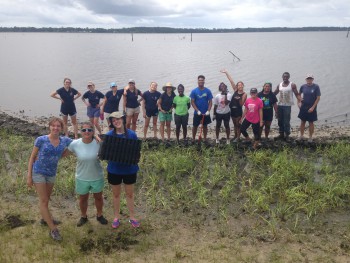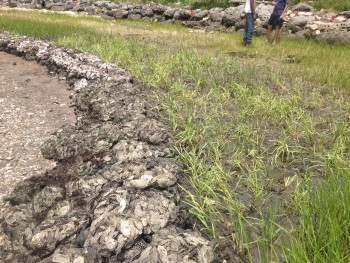
Staff and interns from the federation and counselors from Camp Albemarle planted 2,000 plugs of smooth cordgrass
Staff and interns at the North Carolina Coastal Federation teamed up with counselors from Camp Albemarle on Tuesday, May 31 to protect a shoreline along the Newport River from erosion while also restoring valuable habitat for a long time to come.
The living shoreline, which is 244 feet long and comprised of about 2,000 bags of recycled oyster shells, was built over the past year. The bags were placed right up against the eroding marsh to create a marsh toe revetment that protects the shoreline from waves.
Marsh grass was planted on May 31 landward of the bags to help hold the sediment together and reduce erosion. The marsh grass also helps to filter pollutants from the water and provides habitat for fish, crabs and other species. Rachel Bisesi, coastal education coordinator for the federation, said that Tuesday’s group planted 2,000 plugs of smooth cordgrass. In addition to the plants, the group also added about 100 oyster bags to the marsh toe revetment.
Living shorelines are a much more financially and environmentally practical form of erosion control than hardened structures. They are less expensive than bulkheads and keep marshes healthy by maintaining vital habitats and ecological functions. Bulkheads require expensive repairs and wipe out many of the important functions of coastal ecosystems, such as the ability to filter pollutants from runoff.
This project was partially funded by a grant from the National Oceanic and Atmospheric Administration. The construction of this shoreline began in May 2015 and will be complete after a few more oyster bags are added to the shoreline this summer. Both volunteer groups and interns from the federation have helped with the shoreline project.
If you are interested in learning more about living shorelines and how they provide a natural, healthy way to prevent shoreline erosion, please contact Lexia Weaver at (252) 393-8185.

